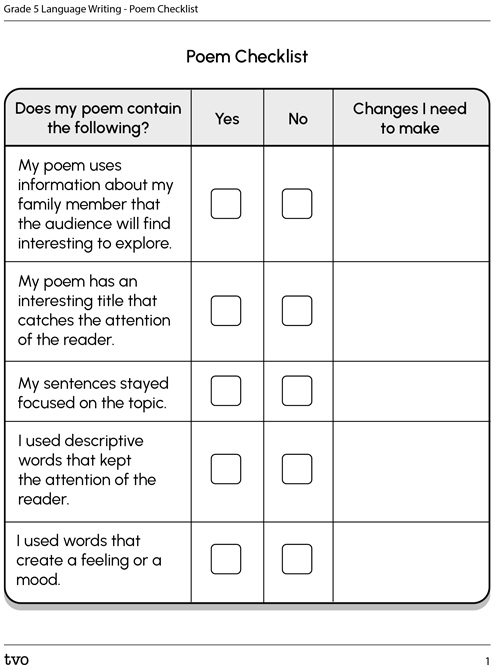Minds On
Ways to express yourself: biography/
autobiography
Writing can be a useful way to explore your feelings. Some people keep diaries or journals, while others just record whatever comes into their head. You might want to record a story about what is happening in your life now or make up a story based on some past event in your life. A story you write about yourself is an autobiography. A story you write about someone else is a biography.

Poetry works for some people, too.
Explore the following poem. Revisit the poem a second time and pay attention to what is being expressed. Note how the poem is biographical in nature – it provides information about someone’s life. What kind of information do you learn? If possible, share your thoughts with a partner.
Samara
Action
Brainstorming
What types of questions do you think an author needs to ask when they research for a biographical poem? Brainstorm 10 to 15 questions that you think would be important to ask. Record your response using a method of your choice.
Some things to consider when researching a biography:
- When and where the person was born
- Important people and places
- Likes and dislikes
- Traditions
- Meaningful life events
- Awards or recognitions earned
- Education
- Favourite things
- Memories
- Things they liked to do
- Things that are important to them
- Personality traits
- Life goals and dreams
- And more
Determine if you have enough questions to gather information to create a biography about a person. If possible, share your thoughts with a partner. Make changes if necessary.
Group the questions into categories such as people, accomplishments, memories etc. These categories will help you form the stanzas of a poem. Organize your thinking using a graphic organizer or another method of your choice.
Brainstorm
A poem about yourself
Now you are ready to create your own autobiographical poem, a poem about yourself.
Answer the questions you developed, based on your own life experience. Arrange your answers into a poem. You may use the poem from the Minds On section as a model to help organize your own biographical poem.
Consolidation
A poem about someone else
You've created an autobiographical poem which was about you! Now you'll create a biographical poem which is about someone else. In this case, it will be about a friend, family member, or someone in your life you find inspirational.

Use the following checklist to help make a final copy. Think about the audience who will be exploring your poem. They will want to be learning something interesting about your family member.
Complete the Poem Checklist in your notebook or use the following fillable and printable document to help you revise your poem.
| Does my poem contain the following? | Yes | No | Changes I need to make |
|---|---|---|---|
| My poem uses information about my family member that the audience will find interesting to explore. | |||
| My poem has an interesting title that catches the attention of the reader. | |||
| My sentences stayed focused on the topic. | |||
| I used descriptive words that kept the attention of the reader. | |||
| I used words that create a feeling or a mood. |
Once you have revised your poem, make a good copy. You may want to attach a picture of the person that you based your poem on. If possible, share your poem with a friend and reflect on how your poems are similar and different.

Reflection
As you read through these descriptions, which sentence best describes how you are feeling about your understanding of this learning activity? Press the button that is beside this sentence.
I feel...
Now, record your ideas using a voice recorder, speech-to-text, or writing tool.








